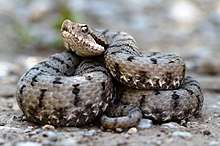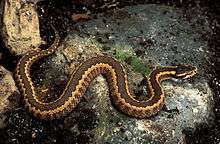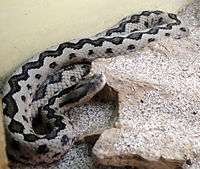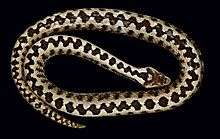Vipera
Vipera /ˈvɪpərə/ is a genus of venomous vipers. It has a very wide range, being found from North Africa to just within the Arctic Circle and from Great Britain to Pacific Asia.[3] The Latin name vīpera is possibly derived from the Latin words vivus and pario, meaning "alive" and "bear" or "bring forth"; likely a reference to the fact that most vipers bear live young.[4] Currently, 25 species are recognized.[5]
| Vipera | |
|---|---|
 | |
| Asp viper, V. aspis | |
| Scientific classification | |
| Kingdom: | Animalia |
| Phylum: | Chordata |
| Class: | Reptilia |
| Order: | Squamata |
| Suborder: | Serpentes |
| Family: | Viperidae |
| Subfamily: | Viperinae |
| Genus: | Vipera Laurenti, 1768 |
| Synonyms [1] | |
| |
- Common names: Palaearctic vipers,[2] Eurasian vipers.[3]
Description
The members of this genus tend to be stout and small in size, the largest of them, V. ammodytes, can reach a maximum length of 95 cm and the smallest, V. monticola, reaches a maximum length of 40 cm.
The heads of the members of this genus are clearly separated from the body, they are triangular in shape and in most species are covered in small scales, although in some species, notably V. berus, have small plates on the top of their heads. Most species have large supraocular scales that tend to extend beyond the posterior margin of the eye. Some species also have some sort of horn on the head, either right behind the nasal scale, or behind the supraocular scales.
The color scheme and camouflage of the members of this genus vary widely, from a grayish ground color with dark brown transverse bands to browner colors with grey transverse bands edged with black in the case of V. ammodytes.[3]
Geographic range
They can be found all around the Old World, hence the common name of the genus, "Old World vipers". they can be found most notably in Europe, from Portugal to Turkey. They can also be found on some islands in the Mediterranean Sea (Sicily, Elba and Montecristo), and the United Kingdom. They can also be found in the Maghreb region of Africa with species living in Morocco (V. monticola) and northern parts of Algeria and Tunisia in the case of V. latastei. Many species can also be found in the Caucasus mountains, parts of Iraq, Jordan, Israel and Syria. Only one species (V. berus) discovered so far lives in East Asia, most notably North Korea, northern China and northern Mongolia[3].
Habitat
Most species prefer cooler environments. Those found at lower latitudes tend to prefer higher altitudes and dryer, rocky habitats, while the species that occur at more northern latitudes prefer lower elevations and environments that have more vegetation and moisture.[3]
Behavior
All species are terrestrial.[3]
Reproduction
All members are viviparous, giving birth to live young.[3]
Venom
Most Vipera species have venom that contains both neurotoxic and haemotoxic components. Bites vary widely in severity.
V. ammodytes is most likely the one with the most toxic venom. In a study solely involving mice, Brown (1973) shows that the LD50 is about 1.2/mg/kg through an IV, 1.5 mg/Kg when injected in the peritoneum (IP) and 2.0 mg/kg when administered subcutaneously.[6]
V. berus venom is considered to be on the lower end of the scale when it comes to toxicity, (Minton, 1974) suggests that the LD50 values for mice are about 0.55 mg/kg IV, 0.80 mg/kg IP and 6.45 mg SC.[7] Venom yield tends to be lower in this species with Minton citing 10–18 mg per bite in specimens 48–62 cm while Brown suggest only 6 mg for the same sized specimens.
However, bites from Vipera species are rarely as severe as those from larger Macrovipera or Daboia.[3]
Species
| Image | Species[1] | Taxon author[1] | Subsp.* | Common name | Geographic range[1] |
|---|---|---|---|---|---|
| V. altaica | Tuniyev, Nilson & Andrén, 2010 | 0 | Eastern Kazakhstan | ||
 |
V. ammodytes | (Linnaeus, 1758) | 4 | Horned viper | North-eastern Italy, southern Slovakia, western Hungary, Slovenia, Croatia, Bosnia-Herzegovina, Serbia, Montenegro, Albania, North Macedonia, Greece (including Macedonia and Cyclades), Romania, Bulgaria, Turkey, Georgia and Syria. |
| V. anatolica | Eiselt & Baran, 1970 | 0 | Anatolian meadow viper | southwestern Turkey | |
 |
V. aspisT | (Linnaeus, 1758) | 4 | Asp viper | France, Andorra, northeastern Spain, extreme southwestern Germany, Switzerland, Monaco, the islands of Elba and Montecristo, Sicily, Italy, San Marino and northwestern Slovenia. |
| V. barani | Böhme & Joger, 1984 | 0 | Baran's adder | Northwestern Turkey. | |
| V. berus | (Linnaeus, 1758) | 3 | Common European adder | From western Europe (Great Britain, Scandinavia, France) across central (Italy, Albania, Bulgaria and northern Greece) and eastern Europe to north of the Arctic Circle, and Russia to the Pacific Ocean, Sakhalin Island, North Korea, northern Mongolia and northern China. | |
 |
V. darevskii | Vedmederja, Orlov & Tuniyev, 1986 | 0 | Darevsky's viper | The southeastern Dzavachet Mountains in Armenia and adjacent areas in Georgia. |
 |
V. dinniki | Nikolsky, 1913 | 0 | Dinnik's viper | Russia (Great Caucasus) and Georgia (high mountain basin of the Inguri River), eastward to Azerbaijan. |
| V. eriwanensis | (Reuss, 1933) | 2 | Alburzi viper, Armenian steppe viper | Armenia, northwestern Iran, northeastern Turkey | |
| V. graeca | Nilson & Andrén, 1988 | 0 | Greek meadow viper | Albania and Greece | |
.jpg) |
V. kaznakovi | Nikolsky, 1909 | 0 | Caucasus viper | Northeastern Turkey, Georgia and Russia (eastern Black Sea coast. |
 |
V. latastei | Boscá, 1878 | 1 | Lataste's viper | Extreme southwestern Europe (France, Portugal and Spain) and northwestern Africa (the Mediterranean region of Morocco, Algeria and Tunisia). |
| V. lotievi | Nilson et al., 1995 | 0 | Caucasian meadow viper | The higher range of the Big Caucasus: Russia, Georgia and Azerbaijan. | |
| V. magnifica | Tuniyev & Ostrovskikh, 2001 | 0 | Magnificent viper | Russia, in the western Caucasus, at elevations 700–1200 m. | |
| V. monticola | H. Saint-Girons, 1954 | 0 | Atlas mountain viper | High Atlas Mountains, Morocco. | |
| V. nikolskii | Vedmederja, Grubant & Rudajewa, 1986 | 0 | Ukraine, central and southern Russia, Romania, Moldova | ||
| V. olguni | (Tuniyev, Avci, Tuniyev, Agasian & Agasian, 2012) | 0 | Turkey, along the Upper Flow of the Kura River. | ||
| V. orlovi [8] | Tuniyev & Ostrovskikh, 2001 | 0 | Orlov's viper[9] | Western Caucasus. | |
 |
V. pontica | Billing, Nilson & Sattler, 1990 | 0 | Pontic adder | Known only from the Coruh valley in Artvin Province, northeastern Turkey. |
| V. renardi | (Christoph, 1861) | 5 | Steppe viper | Ukraine, Russia, Kazakhstan, Kyrgyzstan, Uzbekistan, Tadzikistan, Mongolia, and China. | |
| V. sakoi | Tuniyev, Avci, Tuniyev, ILGAz, OLGun, PetrovA, BoDrov, Geniez, & Teynie, 2018 | 0 | Turkey | ||
 |
V. seoanei | Lataste, 1879 | 1 | Baskian viper | Extreme southwestern France and the northern regions of Spain and Portugal. |
| V. shemakhensis | (Tuniyev, Orlov, Tuniyev, & Kidov, 2013) | 0 | Northeastern Azerbaijan. | ||
| V. transcaucasiana | Boulenger, 1913 | 0 | Transcaucasian long-nosed viper | Republic of Georgia, northwestern Azerbaijan, northern Turkey, and Iran. | |
 |
V. ursinii | (Bonaparte, 1835) | 0 | Meadow viper | Southeastern France, eastern Austria (extinct), Hungary, central Italy, Croatia, Bosnia-Herzegovina, northern and northeastern Albania, Romania, northern Bulgaria, Greece, Turkey, northwestern Iran, Armenia, Azerbaijan, Georgia, Russia and across the Khazakstan, Kirgizia and eastern Uzbekistan steppes to China (Xinjiang). |
| V.walser | Ghielmi, Menegon, Marsden, Laddaga, & Ursenbacher, 2016 | 0 | Piemont viper | Northwestern Italy in the Pennine Alps. | |
* Not including the nominate subspecies. T: type species
References
- McDiarmid RW, Campbell JA, Touré TA (1999). Snake Species of the World: A Taxonomic and Geographic Reference, Volume 1. Washington, District of Columbia: Herpetologists' League. 511 pp. ISBN 1-893777-00-6 (series). ISBN 1-893777-01-4 (volume).
- Spawls S, Branch B (1995). The Dangerous Snakes of Africa: Natural History, Species Directory, Venoms and Snakebite. Sanibel Island, Florida: Ralph Curtis Books / Dubai: Oriental Press. 192 pp. ISBN 0-88359-029-8.
- Mallow D, Ludwig D, Nilson G (2003). True Vipers: Natural History and Toxinology of Old World Vipers. Malabar, Florida: Krieger Publishing Company. 359 pp. ISBN 0-89464-877-2.
- Gotch AF (1986). Reptiles – Their Latin Names Explained. Poole, UK: Blandford Press. 176 pp. ISBN 0-7137-1704-1.
- "Vipera". Integrated Taxonomic Information System. Retrieved 13 August 2006.
- Brown JH (1973). Toxicology and Pharmacology of Venoms from Poisonous Snakes. Springfield, Illinois: Charles C. Thomas. 184 pp. LCCCN 73-229. ISBN 0-398-02808-7.
- Minton SA Jr (1974). Venom Diseases. Springfield, Illinois: Charles C. Thomas. 256 pp. ISBN 978-0-398-03051-3.
- "Vipera orlovi ". The Reptile Database. www.reptile-database.org.
- Beolens, Bo; Watkins, Michael; Grayson, Michael (2011). The Eponym Dictionary of Reptiles. Baltimore: Johns Hopkins University Press. xiii + 296 pp. ISBN 978-1-4214-0135-5. (Vipera orlovi, pp. 196-197).
Further reading
- Arnold EN, Burton JA (1978). A Field Guide to the Reptiles and Amphibians of Britain and Europe. London: Collins. 272 pp. ISBN 0-00-219318-3. (Genus Vipera, pp. 211, 214).
- Boulenger GA (1896). Catalogue of the Snakes in the British Museum (Natural History). Volume II., Containing the ... Viperidæ. London: Trustees of the British Museum (Natural History). (Taylor and Francis, printers). xiv + 727 pp. + Plates I-XXV. (Genus Vipera, pp. 471–472.)
- Laurenti JN (1768). Specimen medicum, exhibens synopsin reptilium emendatam cum experimentis circa venena et antidota reptilium austriacorum. Vienna: Joan. Thom. Nob. de Trattnern. 214 pp. + Plates I-V. (Genus Vipera, p. 99). (in Latin).
External links
| Wikimedia Commons has media related to Vipera. |
- Vipera at the Reptarium.cz Reptile Database. Accessed 6 August 2007.